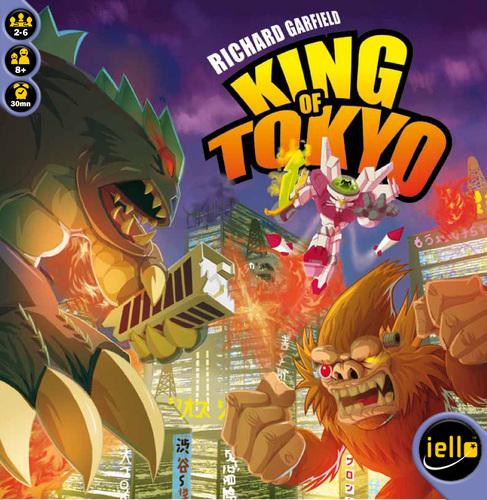Our game, Monster Match, is built taking inspiration from the monster fighting board game King of Tokyo.
Kind of Tokyo is about competing with other players using your monster to win a “battle”. You win either by collecting 20 stars or by being the last monster standing. Players can perform various actions per turn based on die rolls that get them closer to these goals. Players can also “buy” cards that upgrade their monsters in various ways. The game allows for strategy and experimentation while incorporating elements of randomness that keep the competition fun and fresh.
The theme of the game might be summarized as “monster fighting”. The monster fighting narrative layered over the core mechanics adds a degree of fantasy and expression that makes players invested in the competition. As players upgrade their monsters, they grow attached and want them to succeed.
The game utilizes several interesting mechanics such as die rolling and re-rolling, card/upgrade purchasing, attacking and healing, star collecting, and control of Tokyo. These various mechanics provide competing objectives that players must choose between on their turn. Because of die rolling, a player can never achieve exactly what they want each turn. They may reroll a subset of die and must make tradeoffs between what they want to achieve and what is feasible based on their roll.
King of Tokyo offers the player a sense of accomplishment and triumph as their monster prevails over the others. There is also a level of fantasy and expression on top of this competition as players may roleplay their monsters and customize their abilities. These types of fun mesh together to make an enjoyable competitive experience.
To help accomplish this, the graphic design of the game emphasizes the “epic monster battle” theme in many ways. Each player chooses a monster to play as from a selection of King Kong, Godzilla, The Kraken, a robot bunny, a mechanical dragon, and a space alien. The players get a game piece of their monster and a cardboard piece that keeps track of their health and stars. Both pieces include illustrations of their monster, which encourages players to feel a sense of connection to this monster and become engaged in the monster’s success. Cards with special abilities have illustrations showing what these abilities may look like to help the player imagine what it would be like for their monsters to have. The game board is an illustration of Tokyo which the monsters stand atop. All of the graphical elements of the game contribute to the theme of monster fighting to engage the players.
King of Tokyo is very unique in its mechanics which sets it apart from other games in the genre. There are many monster fighting card games in a similar visual aesthetic genre such as Pokemon and Yu-Gi-Oh, but these games emphasize collection and are difficult for people to play if they are not long-time collectors. King of Tokyo is aimed at families and groups of friends so it is self-contained and accessible. Mechanically, King of Tokyo is more similar to board games like Monopoly and Exploding Kittens. The monster-fighting aesthetic, however, increases competition and “epicness” of the battle.
In King of Tokyo, players can be killed by others. In theory, this could lead to abuse if say everyone teamed up unfairly against one player. King of Tokyo subverts this with the Tokyo control mechanic. If a player is King of Tokyo, all other players may attack them, and they attack all other players at once. Therefore, everyone can not “team up” against a player unless that player is currently the King of Tokyo. It is very easy to leave Tokyo and stop being king if your health gets low. This mechanic allows players to team up in certain situations, but not abuse any specific player for the duration of the game.
I would make King of Tokyo better by leaning in to the customization aspect to further enhance expression within the game. I would also make attacking a more powerful strategy. In multiple games, the winner always won through collecting stars and not through being the last monster standing. Attacking is still an important strategy for slowing down one’s ability to collect stars and destroy someone who may be about to win the game, however.



